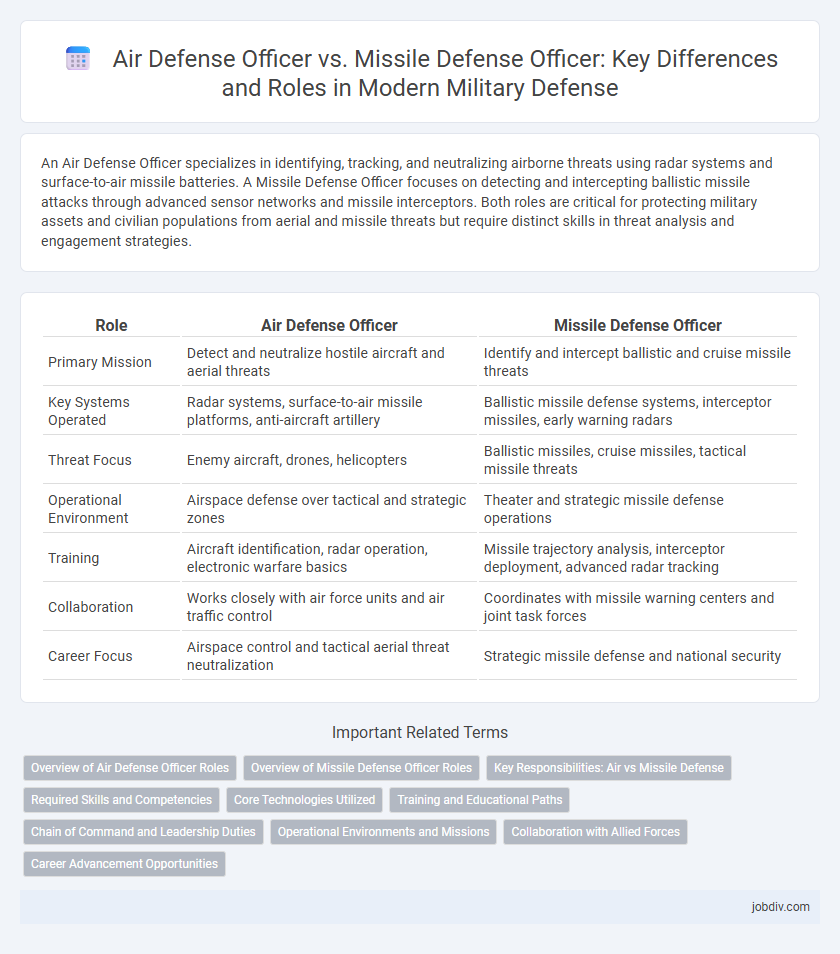An Air Defense Officer specializes in identifying, tracking, and neutralizing airborne threats using radar systems and surface-to-air missile batteries. A Missile Defense Officer focuses on detecting and intercepting ballistic missile attacks through advanced sensor networks and missile interceptors. Both roles are critical for protecting military assets and civilian populations from aerial and missile threats but require distinct skills in threat analysis and engagement strategies.
Table of Comparison
| Role | Air Defense Officer | Missile Defense Officer |
|---|---|---|
| Primary Mission | Detect and neutralize hostile aircraft and aerial threats | Identify and intercept ballistic and cruise missile threats |
| Key Systems Operated | Radar systems, surface-to-air missile platforms, anti-aircraft artillery | Ballistic missile defense systems, interceptor missiles, early warning radars |
| Threat Focus | Enemy aircraft, drones, helicopters | Ballistic missiles, cruise missiles, tactical missile threats |
| Operational Environment | Airspace defense over tactical and strategic zones | Theater and strategic missile defense operations |
| Training | Aircraft identification, radar operation, electronic warfare basics | Missile trajectory analysis, interceptor deployment, advanced radar tracking |
| Collaboration | Works closely with air force units and air traffic control | Coordinates with missile warning centers and joint task forces |
| Career Focus | Airspace control and tactical aerial threat neutralization | Strategic missile defense and national security |
Overview of Air Defense Officer Roles
Air Defense Officers specialize in managing and coordinating the detection, identification, and interception of hostile aircraft to protect airspace integrity. Missile Defense Officers focus on identifying, tracking, and neutralizing incoming missile threats using advanced missile defense systems. Both roles demand expertise in radar operations, threat assessment, and command-and-control systems to ensure effective defense against aerial and missile attacks.
Overview of Missile Defense Officer Roles
Missile Defense Officers specialize in detecting, tracking, and neutralizing missile threats through advanced radar systems and interceptor technologies. Their responsibilities include managing missile defense platforms, coordinating threat response strategies, and ensuring the operational readiness of missile defense units. Unlike Air Defense Officers who primarily focus on aircraft threats, Missile Defense Officers concentrate on countering ballistic, cruise, and tactical missile attacks to protect critical assets.
Key Responsibilities: Air vs Missile Defense
Air Defense Officers oversee the detection, tracking, and engagement of hostile aircraft and unmanned aerial vehicles using radar systems, surface-to-air missiles, and anti-aircraft artillery. Missile Defense Officers specialize in identifying, intercepting, and neutralizing ballistic and cruise missile threats through advanced radar, satellite tracking, and missile interceptors. Both roles require coordination with command centers and integration of defense technologies, but Air Defense focuses on aerial threats while Missile Defense targets missile attacks.
Required Skills and Competencies
Air Defense Officers require expertise in radar operation, threat assessment, and coordination of manned aircraft interception, emphasizing situational awareness and quick decision-making. Missile Defense Officers focus on missile detection, tracking, and engagement systems, requiring skills in sensor integration, electronic warfare, and missile guidance technology. Both roles demand strong communication, strategic planning, and proficiency in defense systems software to effectively neutralize aerial threats.
Core Technologies Utilized
Air Defense Officers primarily utilize radar systems, electronic warfare technologies, and integrated command and control networks to detect, track, and neutralize airborne threats. Missile Defense Officers focus on advanced missile tracking radars, interceptor missile guidance systems, and layered defense architectures designed to counter ballistic and cruise missile attacks. Both roles emphasize real-time data fusion and precision targeting to enhance situational awareness and operational effectiveness in defense scenarios.
Training and Educational Paths
Air Defense Officers primarily undergo rigorous training in radar operations, target identification, and command-and-control systems, often receiving specialized education in tactical airspace management and battlefield communication. Missile Defense Officers focus their training on missile technology, interception strategies, and threat analysis, with advanced studies typically including aerospace engineering and ballistic missile defense systems. Both career paths demand comprehensive knowledge of defense protocols, but missile defense education emphasizes high-tech missile tracking and countermeasure deployment, while air defense centers more on coordinated air threat detection and engagement procedures.
Chain of Command and Leadership Duties
Air Defense Officers oversee strategic command within integrated air defense systems, coordinating units that detect, track, and engage aerial threats to ensure comprehensive area protection. Missile Defense Officers specialize in managing missile combat operations, directing the launch and interception sequences of missile defense systems under strict protocols within the defense chain of command. Leadership duties for both roles involve tactical decision-making, personnel supervision, and coordination with allied units to maintain operational readiness and effective threat response.
Operational Environments and Missions
Air Defense Officers primarily manage the detection, tracking, and engagement of hostile aircraft and cruise missiles within complex, multi-domain operational environments including land, air, and sea theaters. Missile Defense Officers focus on intercepting ballistic missile threats during their boost, midcourse, and terminal phases, often operating within integrated missile defense systems that require rapid decision-making in high-threat scenarios. Both roles demand expertise in radar systems, command and control protocols, and collaboration with joint and allied forces to safeguard critical assets and maintain airspace superiority.
Collaboration with Allied Forces
Air Defense Officers coordinate closely with allied militaries to integrate radar systems and airspace surveillance, ensuring unified responses against aerial threats. Missile Defense Officers collaborate on joint missile detection, tracking, and interception protocols, enhancing real-time threat neutralization across multinational defense networks. Effective communication and shared intelligence platforms between both roles fortify collective defense capabilities against evolving airborne and missile threats.
Career Advancement Opportunities
Air Defense Officers typically advance through roles involving radar operation, aerial threat assessment, and integration of manned aircraft with defense systems, gaining expertise in multi-domain battle environments. Missile Defense Officers specialize in ballistic and cruise missile countermeasures, focusing on sensor fusion, intercept technology, and strategic missile defense operations at command levels. Career advancement for both roles often leads to command positions, joint operational planning roles, and specialized professional military education pathways tailored to national and theater missile defense initiatives.
Air Defense Officer vs Missile Defense Officer Infographic

 jobdiv.com
jobdiv.com